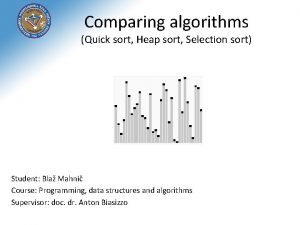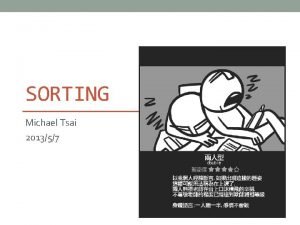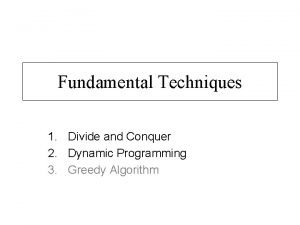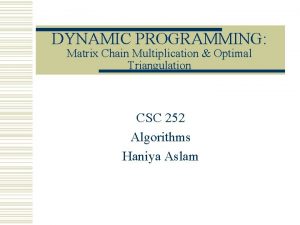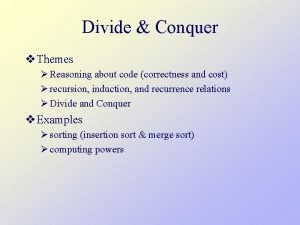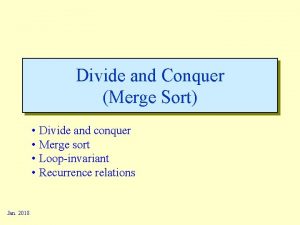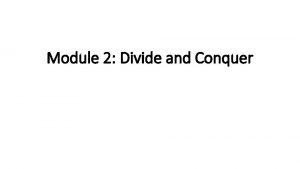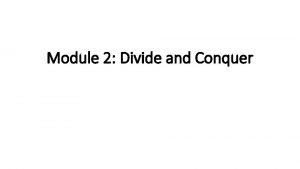Quick Sort Divide and Conquer Algorithms Idea Divide







![Quicksort Code void quick_sort(int first, int last int arr[]) { if (last - first Quicksort Code void quick_sort(int first, int last int arr[]) { if (last - first](https://slidetodoc.com/presentation_image_h2/50d8e4c982ff85a732c6c118d4aead0c/image-8.jpg)
![Partitioning Code int partition(int first, int last, int arr[]) int p = first; int Partitioning Code int partition(int first, int last, int arr[]) int p = first; int](https://slidetodoc.com/presentation_image_h2/50d8e4c982ff85a732c6c118d4aead0c/image-9.jpg)






- Slides: 15

Quick Sort

Divide and Conquer Algorithms! • Idea: • Divide workload in half each time • So you’re working with half the data, then ¼ of the data/ then 1/8 th of the data, etc. • Usually more efficient way of sorting • USUALLY O(n log 2 n)!!! • There a number of Divide and Conquer Sorting Algorithms: • Most notably: • Quicksort • Mergesort

Quicksort • Developed in 1962 by C. A. R. Hoare • Given a pivot value (a number in the array): • Rearranges array into two parts: • All numbers in the left part pivot value • All numbers in the right part > pivot value e. g. , 12, 8, 18, 4, 10, 13, 6, 21, 42 if 12 was the pivot: 8, 4, 10, 6 12 18, 13, 21, 42 Now repeat as if you only have to sort the left set of numbers. Then repeat as if you only have to sort the right set of numbers Students at the end of semester This is so insanely recursive!!! 3

Trace of Algorithm for Partitioning There’s a pivot, an up index, and a down index. • The up index keeps increasing until the value at that index is GREATER than the pivot • The down index keeps decreasing until the value at that index is LESS than the pivot Swap the value at the up index and the down index. Repeat process until up index is greater than down index (NOT the values, the index itself!) Then swap the down index with the pivot Now all values on the left are less than the pivot All values on the right are greater than the pivot But these 2 sections are not necessarily in order!! We have to repeat this whole process with JUST THE VALUES ON THE LEFT And then repeat with JUST THE VALUES ON THE RIGHT! The values on the left NEVER need to be compared with the values on the right again! So we’ve divided the workload! 4

Quicksort Example 44 75 12 43 64 23 55 77 33 44 33 12 43 23 64 55 77 75 23 33 12 43 44 64 55 77 75 23 33 12 43 64 55 77 75 23 12 33 43 55 64 77 75 12 23 33 43 77 75 75 77 Now we have 2 subarrays: Repeat whole process with each subarray separately! 5

In English: • Pick a pivot (we picked the first value in each subarray) • Up holds index at the first value in the subarray (after the pivot) • down holds index at the last value in the subarray • While the up is less than the down: • While up is less than down And subarr[up] is less than pivot: • Increment up to the next value in the array • While down is greater than up And the subarr[down] is greater than the pivot • decrement down to the previous value in the array • If up < down, switch the values in the subarray at up and down • Switch the values at the pivot and the subarr[down] • Now the pivot is in place • All values before the pivot become a new subarray and all the values after the pivot become a new subarray • Repeat until subarrays are of length 1 or 2. 6

Algorithm for Quicksort Just ‘cause it suited my mood First and last are end points of subarray region to sort • • • if first < last Partition using pivot, which is found at piv_index Apply Quicksort recursively to left subarray • Apply Quicksort recursively to right subarray (told ya it was recursive!!!) 7
![Quicksort Code void quicksortint first int last int arr if last first Quicksort Code void quick_sort(int first, int last int arr[]) { if (last - first](https://slidetodoc.com/presentation_image_h2/50d8e4c982ff85a732c6c118d4aead0c/image-8.jpg)
Quicksort Code void quick_sort(int first, int last int arr[]) { if (last - first > 1) { // There is data to be sorted. // Partition the table. int pivot = partition(first, last, arr); // Sort the left half. quick_sort(first, pivot-1, arr); // Sort the right half. quick_sort(pivot + 1, last, arr); } } 8
![Partitioning Code int partitionint first int last int arr int p first int Partitioning Code int partition(int first, int last, int arr[]) int p = first; int](https://slidetodoc.com/presentation_image_h2/50d8e4c982ff85a732c6c118d4aead0c/image-9.jpg)
Partitioning Code int partition(int first, int last, int arr[]) int p = first; int pivot = arr[first]; int i = first+1, j = last; int tmp; while (i <= j) { while (arr[i] < pivot) i++; while (arr[j] > pivot) j--; if (i <= j) { tmp = arr[i]; arr[i] = arr[j]; arr[j] = tmp; i++; j--; } } return p }; { Me End of semester Analysis? Does this preserve stability? What happens with a sorted list? 9

Algorithm Analysis! • Average case for Quicksort is O(n log n) • We partition log n times I see the end! • We compare n values each time (and flip some of them) • This all happens when we always pick an awesome pivot value! • SO almost exactly half the values in the subarray end up BEFORE the pivot and almost half the values in the subarray end up after the pivot • DIVIDING THE WORKLOAD!!! • Because none of the values before the pivot EVER need to be compared to the values after the pivot again! • We know the values on the left are ALL less than the pivot and ALL the values to the right of the pivot are greater than the pivot • Hence in future comparisons, we only have to compare half the values • AND (this is where it becomes n log n) you only have to divide the remaining data into 2 subarrays log n times!) 10

Algorithm Analysis (cont. !) • Stability? ? • Nope! • Could end up swapping a value later in the array in front of the same value earlier in the array • In Place? ? • Yep!! • You only need the array and a temp value for swapping! • This makes it very fast (hence the name…)

Worst case! • Worst case is O(n 2) • What would make the worst case happen? • When the pivot chosen always ended up with all values on one side of the pivot • When would this happen? • Sorted list • (Let me reiterate – quicksort’s worst case time analysis is when it sorts a sorted list) • (brain just exploded!!) • Why? • The pivot would be the first number in the array. • If the list is already sorted, this would be the SMALLEST number in the array • So if partitioning around this pivot, ALL the other numbers would be AFTER the pivot • We didn’t just divide the array into two equal parts! • UGH!!!

Possible Solutions (to make quicksort time closer to O(n log n): • The worst case occurs when list is sorted or almost sorted • First solution: • Scramble the array before you use quicksort. • Yep, I just told you to UNSORT an ALREADY SORTED array in order to make quicksort more efficient • Your brain just exploded again, didn’t it. 13

Possible Solutions (to make quicksort time closer to O(n log n): • The worst case occurs when list is sorted or almost sorted • Solution that won’t make your brain explode): Pick a better pivot: Method 1: Use the middle element of the subarray as pivot. Method 2: Use a random element of the array as the pivot. Method 3: Perhaps best: take the median of three elements as the pivot. • • Use three “marker” elements: first, middle, last • Let pivot be one whose value is between the others With any of the above methods, the odds of choosing as a pivot either the smallest or largest value in the array are small • • Especially every time! This makes it more likely that the running time will be O(n log n) • Even though the worst case will always be O( n 2) 14

Take. Aways: • Quick. Sort: Divide and Conquer Algorithm • Pick a pivot • All values less than pivot moved to left • All values greater than pivot moved to right • Recursively call quicksort on the left and on the right sides • IS NOT stable • Is in-place • Average running time is O( n log n) • And we can pick a pivot wisely to help make it more likely the running time will be n log n • But worst case will be O (n 2)
 Insertion sort divide and conquer
Insertion sort divide and conquer Selection sort vs heap sort
Selection sort vs heap sort Quick sort merge sort
Quick sort merge sort Quick sort merge sort
Quick sort merge sort Decrease and conquer algorithm
Decrease and conquer algorithm Divide and conquer advantages and disadvantages
Divide and conquer advantages and disadvantages Greedy vs divide and conquer
Greedy vs divide and conquer Delaunay triangulation divide and conquer algorithm
Delaunay triangulation divide and conquer algorithm Delaunay triangulation divide and conquer algorithm
Delaunay triangulation divide and conquer algorithm Counting inversions divide and conquer
Counting inversions divide and conquer Divide et impera
Divide et impera Divide and conquer
Divide and conquer Dynamic programming vs divide and conquer
Dynamic programming vs divide and conquer Divide and conquer
Divide and conquer Divide and conquer algorithm
Divide and conquer algorithm Skyline problem divide and conquer java
Skyline problem divide and conquer java

